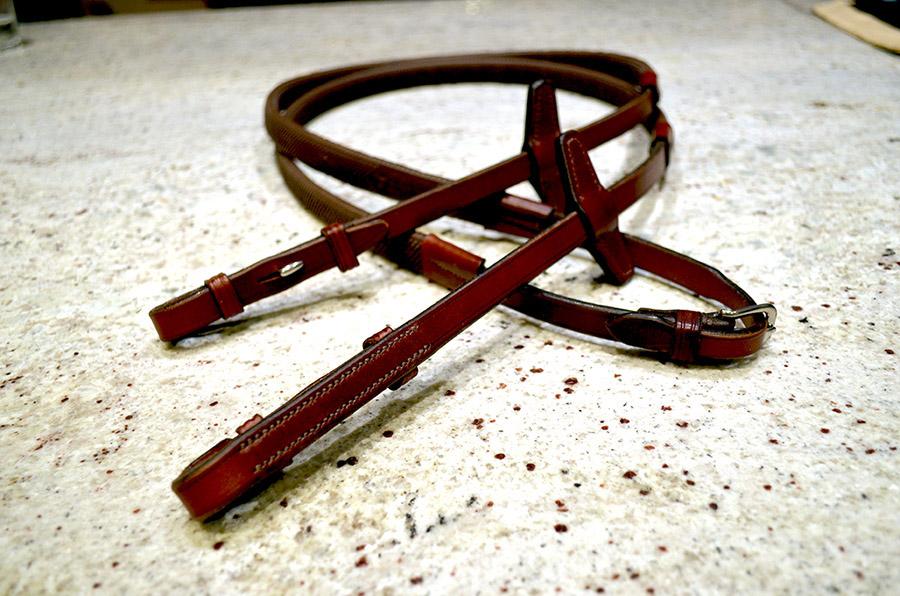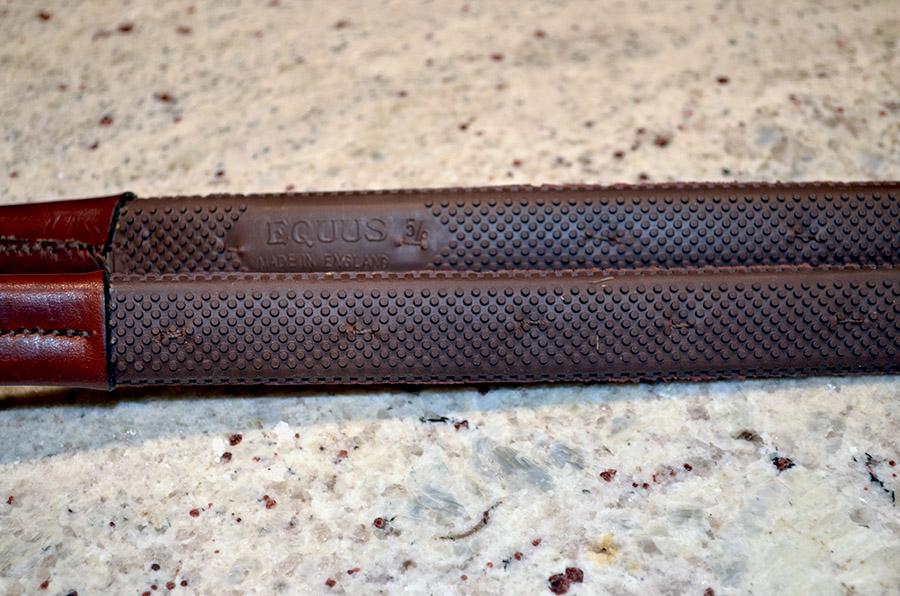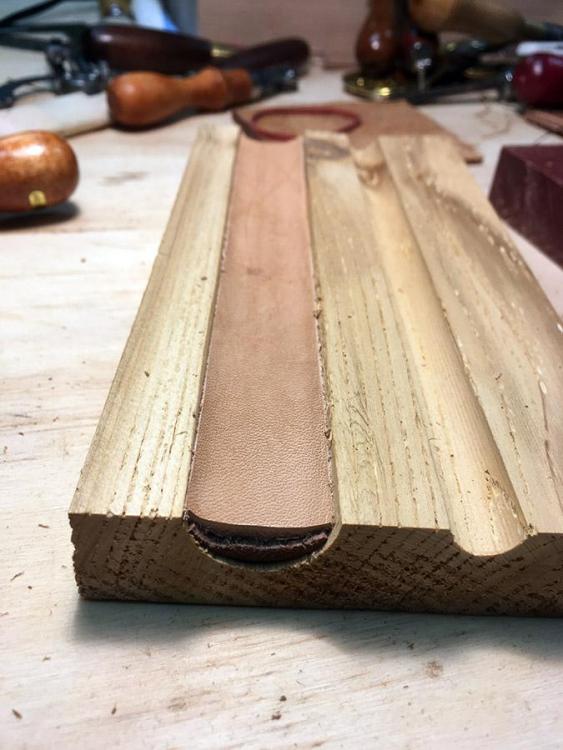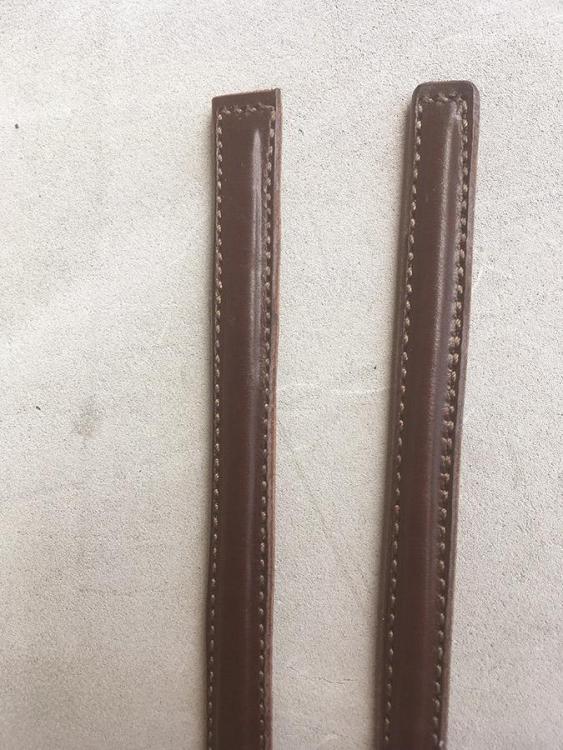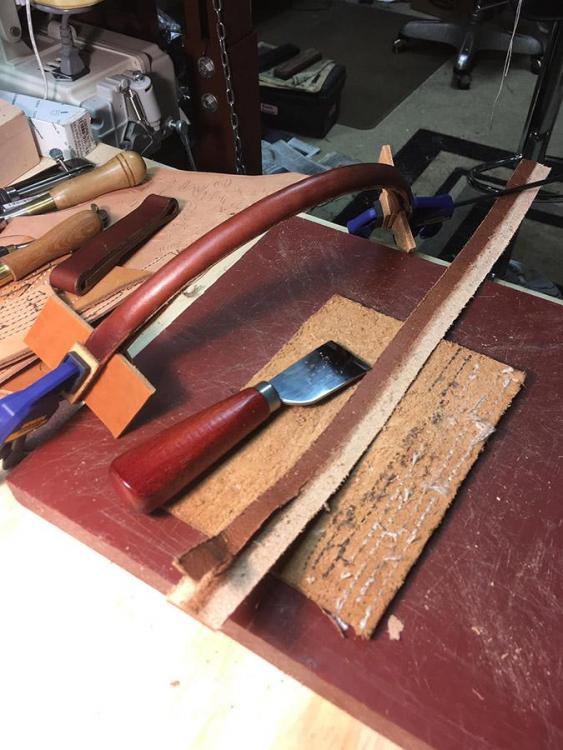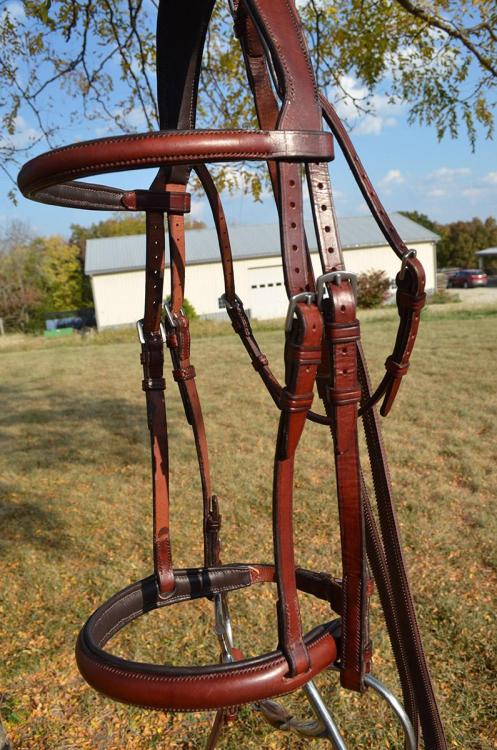-
Posts
1,284 -
Joined
-
Last visited
Content Type
Profiles
Forums
Events
Blogs
Gallery
Everything posted by TomE
-
If it takes up water normally then it's probably fine. Can dye a test piece to be sure. A safe bet is to clean the surface with Fiebings Deglazer. I have used Deglazer to prep bridle leather that I dyed with Fiebings Pro black dye. It removed the waxy surface and a bit of brown dye from the bridle leather. The black dyed piece looks and wears like black bridle leather from the tannery.
-
Thanks. I think I spent about 30 min pop stitching each rein. I see it would be better to include a stitch over each end of the cuff to secure the edge. Learn something with each one I make.
-
Finished the 5/8" reins and used a pop stitch to secure the rubber grips, per @jcuk's advice. This running stitch is done by angling the awl to separate the stitches and minimize the number of holes in the leather reins. For reins I made previously, I sewed along the length of the grips using a machine. These reins were made for the winning bidder of a silent auction to support educational programs of the American Hanoverian Society breed registry.
-
I will look into the sole stitcher option. I can sew raised leather pieces with a small border but not the swells that have no border. Here are some practice raised pieces. I would use a smaller needle and thread for the real item. The swells are two layers of skived leather with a padded liner added for a halter. The pictures below show a swell being shaped in the rounding block, and a skived strap along with a shaped swell ready for sewing. The bridle picture shows the hand sewn item.
-
The paddle foot might be worth a try. For raised leather pieces, I have used an inline presser foot. It requires a bit more border than I want on the finished piece but I can trim after sewing. For swells that taper continuously and have no border along the edge I am uncertain how to sew them on a machine. The process of forming the swell by skiving and shaping 2 layers in a rounding block is not conducive to leaving a border that can be trimmed after sewing. Additionally, the padded liner sewn on the bridle pieces would interfere with trimming the edges after sewing. I guess this bridle is designed to be hand sewn. I agree that for machine sewing at 8+ SPI I would need to use a smaller thread and needle.
-
Look forward to hearing about this custom feed dog/plate. I am on the lookout for methods to machine sew bridles that I now sew by hand. I have a Cobra 4 and don't see myself buying a second machine at present for my tack making hobby. 9-10 oz leather with #207 thread @ 9-10 SPI. Particularly interested in how to navigate along the edge of a swelled noseband.
-
Here are links to the information that @kgg mentioned above. I use the narrow feed dog and plate for everything on my Cobra Class 4 and find it easier to switch between heavy and lightweight leathers. https://www.rw-leatherworks.com/blog/2019/02/dumbing-down-a-cowboy-cb4500-cobra-class-4-or-similar-harness-stitcher.html
-
Thanks once again, @jcuk! I will use a machine on these reins and practice pop stitching on some scrap. Finding my groove as I make more pairs of reins. I appreciate your help.
-
Thanks for the additional info. I really appreciate learning from your experience. Here's a picture of the 5/8" grips without the thick rubber cuff seen on the 3/4" reins above. I did split some bridle leather to make cuffs for these grips. Is it necessary to sew along the length of the grip to secure it? These grips fit snugly on the strap but I suppose they might stretch if someone cranks on the reins. Steinke recommends using a single needle pop stitch. I previously used a machine because that's how the Antares reins are constructed. What do you do?
-
There are 2 aspects to consider. The spacing and the size of the holes. A pricking iron is designed to mark locations of holes that will be created with a sewing awl. Awls are shaped and sharpened to create different sizes that are matched to thread size. The goal is to use the smallest awl that will accommodate the thread size and needles, so that the holes will close around the thread. Fine bridlework features stitching at 12-14 SPI, which you can't achieve with larger holes created with a punch or chisel. So the optimal stitch length is a matter of aesthetic, but limited by the size of the holes you create. With small holes you can do fine stitching that is very strong.
-
Well, you probably can't see it in the pictures but all the buckles are sewn with the fixed loop tight to the buckle and with side stitches to gather the buckle turn, as you recommended. My process for the rubber reins is to bevel the edges of the strap, punch a hole near the best end (to become the billet end), loop parachute cord through the hole, fish the cords through the grip, tie the cords to my workbench, and milk the grip onto the strap. I trim and finish the ends, crease the strap, etc. after the grips are in place. The 3/4" grips with rubber cuffs were a struggle to get on. I just received 5/8" Equus grips without rubber cuffs and they went on snugly without any problem. I need to make cuffs for the 5/8" reins on my bench now, so I'll try splitting some bridle leather for the cuffs. How many times can you recover reins? Wondering how the small pips will hold up in comparison to large pips. Thanks, @Backwoodsman.
-
Thanks, @chuck123wapati!
-
You could machine stitch the belt and finish the keeper end by hand, leaving long tails of thread to incorporate a fixed loop/keeper next to the buckle. I do this on some halter parts where the hardware creates a bulge that my machine won't climb. If you'd rather have a sliding loop/keeper that is secured with Chicago screws here is a video showing the traditional way to make sliding loops using a single needle backstitch.
- 11 replies
-
Thanks. I guess I should learn something else to use the remainders of several hides. Thank you. Yes, these are Equus rubber grips from Abbey England. I worked on a pair of Antares reins that had nylon webbing under the grips, stitched to leather pieces on the billets and buckle ends. I made mine from a single leather strap. These are 3/4" reins (grips are about 1-1/8" wide) and I plan to make 5/8" reins for our petite horse trainer. The grips come with either small pips (very grippy) or large pips (smoother). It takes enough force to pull them over the strap that the strap stretches a bit, so I put the grips on before sizing the length. I placed a line of machine stitching down the center to secure the grips. Some of the Equus grips have rubber cuffs on the ends, which I left exposed. The traditional style is to cover the ends of the grips with a leather cuff made of 3-4 oz chrome tanned leather.
-
This is bridle #3 for me and I am enjoying the learning process. At this stage, I give away everything I make to people who use it and give me feedback to improve my craft.
-
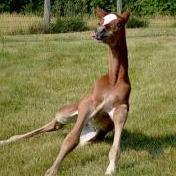
Prize Winning Hand Bag
TomE replied to Handstitched's topic in Purses, Wallets, Belts and Miscellaneous Pocket Items
Congratulations! Very nice work. -
This knife is called a "crease" on the English version of Vergez-Blanchard's website.
-
Thanks for the info. Looks like a very handy tool. Nicely finished too.
-
I really like @chuck123wapati's knife but I'm confused about using it for long straight cuts. Based on my experience with a single bevel plough knife I'd expect the blade to track away from the bevel. I use a traditional round knife for long straight cuts when squaring up hides. This looks like a pattern knife or skiving knife for fine work. Interested in learning more about this.
-

Contact cement
TomE replied to Scottgallagher's topic in Dyes, Antiques, Stains, Glues, Waxes, Finishes and Conditioners.
Ha Ha! The only thing I don't like about the original is the price, but that's a small fraction of supply costs so I keep using it. -
My favorite conditioners are Fiebings Aussie and Effax Leder Balsam, which are both balm type conditioners that don't darken the leather. The Aussie conditioner is a bit more waxy than Leder Balsam, which soaks in faster. Bick 4 and Blackrock Leather N' Rich are also good but I see some change in color.
-

The leather stretches as i start to skive it what do i do
TomE replied to hickok55's topic in How Do I Do That?
Haven’t worked with goat leather but I do most of my skiving on a scrap of heavy leather with flesh side up. Glass or marble is too slick and the bridle leather I’m skiving slides around. More friction might keep the goat leather from stretching? -

Kangaroo skin bag
TomE replied to AndrewWR's topic in Purses, Wallets, Belts and Miscellaneous Pocket Items
@AndrewWR, makes sense. I’ll be interested to know how the Tokenole holds up. Did not know about the kangaroos in CA. Chrome tanned cow hide seems perfectly adequate for liners although I did plan to use kangaroo lace for laced reins. -

Kangaroo skin bag
TomE replied to AndrewWR's topic in Purses, Wallets, Belts and Miscellaneous Pocket Items
That's a handsome bag! I do a lot of strapwork with bridle leather. My favorite edge treatment is burnishing with canvas and sealing with beeswax using a heated edge iron. Adding a crease line will also dress up a strap. Thinking about trying kangaroo for padded liners on halters and bridles. I like the design of your bag. -
Good looking bags! I especially like the tulips. Is it correct that chrome tan is stronger than veg tan with respect to tearing and seams ripping out?



